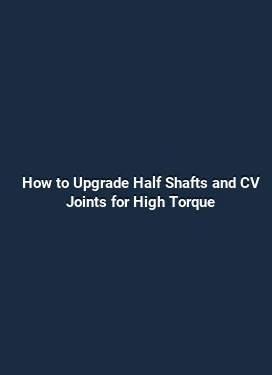Single Clutch vs Twin Clutch vs Triple Clutch for High Torque Applications
When evaluating transmission architectures for high torque drivetrains, the choice among single, twin, and triple clutch configurations profoundly shapes performance, durability, and drivability. This in-depth analysis dissects the operating principles, strengths, and trade-offs of each setup, with a focus on real-world applications, thermal management, engagement behavior, and long-term reliability. The discussion spans fundamental mechanics, control strategies, lubrication regimes, and maintenance considerations that are critical for engineers, technicians, and enthusiasts working with high-torque systems in motorsport, heavy machinery, and high-performance road vehicles.
Overview of Clutch Configurations for High Torque

Clutch configurations in manual or automated manuals primarily differ in how torque is distributed across multiple friction surfaces. A single clutch employs one friction interface to engage or disengage the drivetrain. Twin and triple clutch systems introduce additional friction surfaces and hydraulic or pneumatic actuation stages, enabling smoother engagement, better torque handling, and refined modulation. In high torque contexts, the ability to split load across multiple clutches reduces peak stresses, improves heat dissipation, and can enable more favorable gear ratios and reduced lockup events. However, each configuration introduces its own complexity, weight, and cost considerations. Understanding the interaction between clutch packs, input and output shafts, and the transmission’s control logic is essential to selecting the appropriate architecture for a given torque target and operating envelope.
Historical trends show a progression from single-clutch designs in early performance cars to increasingly sophisticated multi-clutch systems in modern performance and race applications. The objective is to maintain consistent clamping force, minimize slip, and preserve drive feel under high torque while managing thermal loads that otherwise degrade friction materials and lubricant performance. The following sections explore core differences, practical implications, and design considerations that influence decision-making in high-torque scenarios.
Core Differences: How Clutch Configurations Manage Torque
Single clutch configurations rely on a single friction surface to transmit torque. While simple and compact, a lone clutch tends to experience higher contact pressures for the same torque compared to multi-clutch setups. This can lead to accelerated wear, greater peak temperatures, and potentially abrupt engagement if the control strategy is not finely tuned. In contrast, twin and triple clutch arrangements distribute torque across multiple surfaces, effectively reducing the load on each clutch and enabling higher aggregate torque capacity without proportionally increasing stress per element. In practice, this translates to smoother engagements, improved modulation at high speeds, and enhanced resilience to heat exposure over extended operation.
Multi-clutch systems also introduce redundancy in engagement sequencing. For example, a dual-clutch design can pre-engage an alternate pack as another releases, enabling near-seamless gear shifts with reduced torque interruption. This capability is particularly advantageous in applications requiring rapid, repeatable shifts under high torque, such as performance driving or heavy-duty off-road use. The trade-offs include greater mechanical complexity, more sophisticated control algorithms, and an increased likelihood of lubrication and clutch-face wear interactions that demand careful maintenance planning.
Single Clutch, Twin Clutch, and Triple Clutch: Core Differences

The single clutch architecture uses a single friction pair, a single actuation mechanism, and a straightforward hydraulic or electro-hydraulic control loop. Its simplicity yields light weight and lower cost, but the torque that can be transmitted without slip is inherently limited by material strength and cooling capacity. A twin clutch system introduces a second friction surface, commonly paired with two actuators and a shared or coordinated control strategy. This arrangement enables better torque distribution, smoother disengagement, and often improved efficiency in gear selection under load.
A triple clutch configuration expands the concept further by incorporating a third friction interface. This design can provide the most favorable balance between torque capacity and engagement quality, particularly in extreme high-torque regimes or in vehicles requiring frequent rapid shifts with minimal transmission shock. Triple clutch systems benefit from advanced thermal management and sophisticated control sequencing to ensure even load sharing among all packs, which is critical to maintaining performance consistency as temperatures rise during aggressive operation.
Thermal Management and Material Considerations
High torque applications inherently elevate heat generation within clutch packs. Effective thermal management hinges on three pillars: friction material selection, lubrication strategy, and cooling efficiency. In single clutch systems, the heat sink is often the surface area of the clutch plate and the surrounding housing, which can become a limiting factor at sustained high torque. Twin and triple clutch arrangements distribute thermal load across multiple packs, reducing the peak temperature per surface and allowing longer operation under heavy load before thermal soak occurs. This is particularly beneficial in endurance racing or continuous heavy-haul operations where sustained torque output is essential.
Friction materials for high torque must balance coercive friction, wear resistance, and heat tolerance. Common materials include ceramic composites and advanced metallics engineered for high-temperature stability. However, material choices must harmonize with lubricant chemistry, cooling passages, and the clutch’s use-case profile. In multi-clutch designs, ensuring consistent engagement across all packs requires careful calibration of clamp loads, pre-load conditions, and dynamic pressure modulation to prevent cross-pack slip and to maintain uniform wear patterns. Such considerations are critical to preserving performance over the clutch’s service life and to avoiding disproportionate wear that could compromise torque transmission or smoothness.
Lubrication Strategies and Oil Life
Lubrication plays a pivotal role in friction surface longevity. In high-torque transmissions, synthetic oils with high viscosity indices and robust thermal stability are favored to maintain film strength and minimize scuffing. Multi-clutch systems often feature dedicated lubrication loops for each pack or strategically designed oil routing to ensure consistent cooling. Regular oil condition monitoring, including checks for viscosity changes and particulate contamination, helps preempt wear at the clutch contact surfaces. Protective additives and anti-wear formulations contribute to extended service intervals, provided maintenance schedules are followed and operating temperatures stay within designed ranges.
Performance Implications: Engagement, Shift Quality, and Responsiveness
Engagement quality directly affects driver confidence and vehicle behavior during acceleration and corner exits. Single clutches can deliver decisive engagement, but high-torque demands may force operators to accept a certain amount of pedal effort or engagement harshness unless a sophisticated control strategy is implemented. Twin and triple clutches, by enabling staged engagement, can achieve smoother transitions with reduced torque interruption. This translates to quieter operation, better traction consistency, and improved acceleration performance under load. The trade-off is the need for more advanced control electronics and more precise calibration to achieve predictable feel across a broad operating window.
Shift quality in high-torque transmissions benefits from multi-clutch architectures through controlled torque transfer during clutch engagement and disengagement. In practice, pre-engagement of alternate packs minimizes the momentary loss of drive, allowing tighter shift intervals and improved stability under aggressive gear changes. For racing disciplines with rapid gear changes, the ability to manage clutch slip and lock-up rates can be the difference between maintaining momentum and incurring a pep-in-the-step during shifting. In everyday driving, refined control reduces driveline shock and preserves tire grip, contributing to a more composed and predictable vehicle feel.
Control Strategies and Sensor Integration
Modern high-torque transmissions rely on a combination of hydraulic, electronic, and mechanical feedback to optimize clutch operation. Sensors monitor parameters such as clutch temperature, pack pressure, slip ratio, and shaft speed. The control system interprets this data to modulate hydraulic pressure, pre-load, and engagement timing. Multi-clutch designs require coordination among packs to ensure even load distribution and consistent friction behavior, particularly as temperature rises. Real-time diagnostics help technicians monitor wear trends and pre-empt failures before they affect performance or safety.
Applications by Torque Class and Use Case
Torque class and application profile strongly influence the suitability of each clutch configuration. Light to moderate torque scenarios may be efficiently served by a well-optimized single clutch with advanced materials and thermal management. For mid-range to high-torque demands that require rapid shifting with minimal interruption, twin clutch systems present a compelling balance of performance and complexity. In extreme high-torque environments—such as competitive motorsport, heavy off-road, or industrial transmissions—triple clutch configurations can offer the highest torque transmission capacity and the most refined engagement behavior, provided the system is paired with robust cooling, precise control, and meticulous maintenance planning.
Practical deployment examples include dual-clutch systems in high-performance road cars where seamless shifts and torque handling under acceleration are paramount, and triple-clutch architectures in specialized race or heavy-duty platforms where the objective is maximum repeatable torque delivery across demanding duty cycles. The selection process should consider drive cycle characteristics, expected peak torque, gear ratio strategy, and the durability requirements of the drivetrain as a whole.
Maintenance, Diagnostics, and Reliability
Maintenance for high-torque clutch systems emphasizes fact-based inspection, proactive parts replacement, and lubricant management. Regular diagnostics should include slip trend analysis, engagement time checks, and temperature profiling across clutch packs. For multi-clutch configurations, verifying even wear across packs is crucial; imbalanced wear can create uneven engagement forces, reduce shift smoothness, and eventually limit torque capacity. Reliable operation also depends on keeping the lubrication system free of contaminants and ensuring that cooling channels remain unobstructed. Adhering to manufacturer-recommended service intervals and using OEM-approved components significantly reduces the risk of unexpected failures under load.
Diagnostics often leverage data logging to capture transient events during shifts, which helps identify borderline clutch packs that may be approaching wear limits. Analysts can correlate temperature spikes with specific operating conditions to fine-tune cooling strategies and clamp loads. In performance environments, a structured maintenance plan that includes clutch pack inspection, bearing checks, and seals condition assessment contributes to sustained performance and extended service life. Documentation of wear patterns and calibration settings supports traceability and future upgrades as torque targets evolve.
Future Trends: Materials, Control, and Efficiency Gains
The drive toward higher torque density while preserving drivability continues to push developments in friction materials, composite substrates, and cooling technologies. Lightweight, high-thermal-conductivity materials enable more aggressive packaging and shorter warm-up times, which translates to improved response under load. Advanced control strategies, including adaptive pre-load modulation and machine learning-informed shift sequencing, promise to deliver consistent engagement across a wider range of temperatures and wear states. The integration of predictive maintenance analytics with embedded sensors supports proactive interventions that minimize downtime and maximize uptime during critical operation windows.
Additionally, trend terminology emphasizes system-wide efficiency and reliability. Engineers monitor torque split ratios, clutch biasing, and thermal margins to optimize not just peak torque capacity but real-world consistency. In high-torque applications, the synergy between mechanical design and software control defines the ultimate limits of performance, drivability, and longevity. By aligning material science, lubrication science, and control engineering, future multi-clutch transmissions can deliver higher torque with smoother operation, reduced energy losses, and longer service intervals.
Design Considerations for Implementation
When planning a multi-clutch system for high torque, designers evaluate the footprint of the clutch packs, the feasibility of removing heat from dense friction surfaces, and the compatibility of the system with existing driveline architecture. A well-integrated solution accounts for gear set geometry, input shaft diameter, selector mechanism, and the reliability of seals and bearings under cyclic loading. Simulation tools help model heat buildup, slip behavior, and load sharing among packs, enabling iterative optimization before a prototype is built. Ultimately, the goal is to deliver a transmission that maintains linear torque delivery, predictable engagement, and consistent shift feel across the vehicle’s entire operating envelope.
In performance-focused programs, integration with traction control, stability systems, and driver-aid features becomes increasingly important. Coordinated control across the clutch packs helps preserve cornering grip and throttle response, especially when the drivetrain is pushed to its torque limits. The result is a more confident driving experience, with a consistent drivetrain response that fosters better lap times and more predictable performance under race conditions.
Summary of Practical Takeaways for Engineers and Enthusiasts
For high torque applications, the choice between single, twin, and triple clutch configurations should be guided by torque targets, duty cycle, and desired shift quality. Single clutches offer simplicity and compactness, but may struggle under sustained high loads. Twin clutches provide improved load sharing and smoother engagement with moderate added complexity. Triple clutches deliver the highest potential torque capacity and the most refined engagement, at the cost of substantial system complexity and maintenance considerations. Regardless of the chosen architecture, effective thermal management, robust lubrication, and precise control are essential to achieving durable, high-performance operation.
As the drivetrain landscape evolves, the intersection of advanced materials, sophisticated control algorithms, and enhanced cooling strategies will continue to push the boundaries of what is possible in high-torque transmissions. Stakeholders should prioritize a holistic design approach that accounts for mechanical, thermal, and electronic factors in equal measure, ensuring that the chosen clutch configuration delivers the desired balance of performance, reliability, and efficiency across the vehicle’s expected life cycle.






